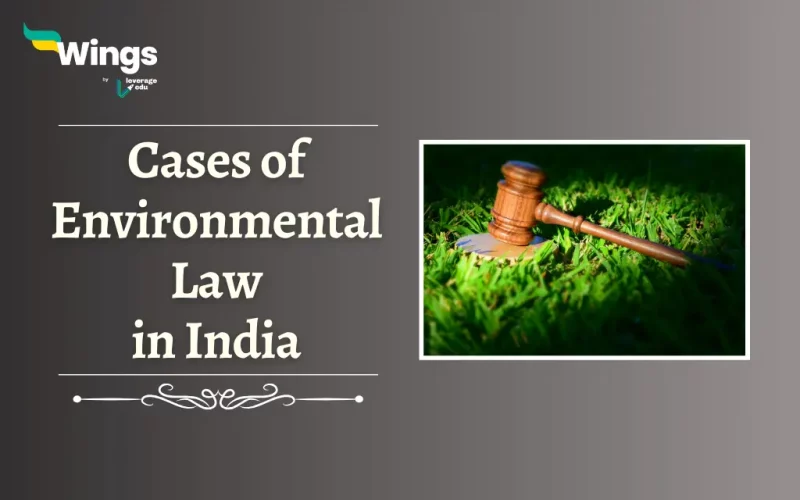The diversity of our nation India in culture also expands to nature and our environment. Moreover, due to man-made activities, several environmentally depreciating factors come into play. However, there have been citizens of India who know their rights and have gone against people who want to use nature as a resource for their gain. These people have fought Cases of Environmental Law and realise the importance of protecting our environment. Read on to learn more about these Cases of Environmental Law in India, the Environmental Law Court Cases and a recent Landmark Case on Environmental Law in 2024.
Table of Contents [show]
Environmental Law Court Cases
Furthermore, here are seven milestone Environmental Law Court Cases that have established noteworthy examples:
M.C. Mehta vs. Union of India (Ganga River Pollution Case) in 1988
This case by environmental lawyer M.C. Mehta is a landmark judgment. Moreover, it highlighted the extreme pollution of the Ganges, a holy river for millions.
- The Supreme Court of India’s verdict ordered polluting industries near Kanpur.
- Hence setting a strong example for holding industries responsible for environmental damage.
Subhash Kumar vs. State of Bihar in 1991
This case in 1991 established the “Right to a Pollution-Free Environment” as a necessary part of the Fundamental Right to Life (Article 21) in the Indian Constitution.
- Additionally, this judgment empowered citizens to get legal solutions against environmental degradation which was affecting their well-being.
Vellore Citizens Welfare Forum vs. Union of India in 1996
In 1996, this milestone case of Environmental Law addressed the issue of tanneries polluting the Palar River in Tamil Nadu.
- The Supreme Court of India highlighting the “Polluter Pays” regulation, directed the tanneries to adopt cleaner technologies and pay for the damage caused.
- Therefore, this judgment maintained the principle of holding polluters financially accountable for environmental harm.
M.C. Mehta vs. Kamal Nath and Ors. in 1996
Another case in 1996 is one in which the Supreme Court of India criticised the Himachal Pradesh government for leasing a protected forest area for commercial purposes.
- Moreover, this case put forth the “Public Trust Doctrine,” which orders the government to act as a trustee for environmental resources, thus holding them responsible for future generations.
Indian Council for Enviro-Legal Action vs. Union of India in 1996
This milestone case of Environmental Law involved the environmental impact of the Tehri Dam project in the Himalayas.
- In addition, the Court after realising the potential ecological devastation had ordered an Environmental Impact Assessment and public hearings before proceeding with the project.
- Furthermore, this case established the importance of Environmental Impact Assessments for large-scale development projects.
T.N. Godavarman Thirumulpad vs. Union of India in 1996
Yet another case in 1996, this case addressed the controversial issue of mining in ecologically fragile areas of the Aravalli Hills.
- The Court imposed a ban on mining activities, thus putting environmental protection first over economic gains.
- Moreover, this judgment emphasised the delicate balance between development and environmental sustainability.
Murli S. Deora vs. Union of India in 2002
This milestone case of Environmental Law tackled the alarming issue of air pollution in Delhi due to the operation of non-CNG (Compressed Natural Gas) buses.
- The Supreme Court of India ordered the phasing out of these polluting vehicles.
- Thereby promoting cleaner alternatives and paving the way for stricter emission control standards in India.
Therefore, these landmark cases represent important milestones in India’s environmental journey.
Also Read: Forest (Conservation) Amendment Act 2023: History, Changes
Recent Landmark Case on Environmental Law in 2024
On the 8th of April 2024, the Supreme Court of India recognised the Right to Be Free From Adverse Effects of Climate Change.
- For the first time, the Supreme Court recognizes the “Right To Be Free From Adverse Effects Of Climate Change” as an essential human right.
- Thereby paving the way for legal action against the government and industries for policies that worsen Climate Change and its negative impacts on the citizens of India.
However, the fight for clean air, water, and sustainable development continues. Moreover, these milestone cases are a beacon of hope, hence inspiring continuous efforts to protect India’s precious environment for generations to come.
Related Blogs
Lastly, we hope you liked our blog and gained an understanding of the Milestone Cases of Environmental Law in India. Moreover, you may even read more blogs and empower yourself with knowledge regarding Civics and Polity!
 One app for all your study abroad needs
One app for all your study abroad needs















 45,000+ students trusted us with their dreams. Take the first step today!
45,000+ students trusted us with their dreams. Take the first step today!
